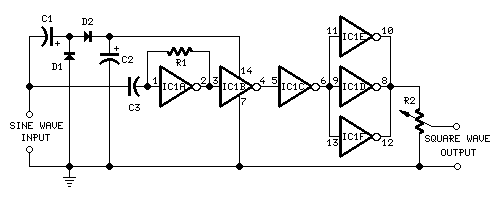FREE
circuits!
How to build Self-powered Sine to Square wave Converter
November 16, 2010 - category: MiscellaneousConverts sine to square waves without a power-source
Useful as a test instrument for audio purposes
Circuit diagram
Parts:
- R1 1M 1/4W Resistor
- R2 100K Linear Potentiometer
- C1,C2 100µF 25V Electrolytic Capacitors
- C3 10nF 63V Polyester Capacitor
- D1,D2 1N4148 75V 150mA Diodes
- IC1 4069 Hex Inverter IC
Device purpose:
This circuit is intended to provide good square waves converting a sine wave picked-up from an existing generator. Its major feature consists in the fact that no power-source is needed: thus it can be simply connected between a sine wave generator and the device under test. The input sine wave feeds a voltage doubler formed by C1, C2, D1 & D2 that powers the IC. IC1A amplifies the input sine wave, other inverters included in IC1 squaring the signal and delivering an output square wave of equal mark/space ratio and good rise and fall times through the entire 20Hz-20KHz range.
Notes:
- Best performances are obtained with an input sine wave amplitude from 1V RMS onwards.
- Output square wave amplitude is proportional to input amplitude.
- Minimum sine wave input amplitude needed for good performance: 750mV RMS.
- Output square wave amplitude with 1V RMS input: 3V peak to peak, with R2 set at max.
- Minimum output square wave amplitude: 2V peak to peak, with R2 set at max.
- Substituting the two silicon diodes with germanium types (e.g. AA118, AA119), the minimum input threshold can be lowered.
This circuit won £50 and was published on ELECTRONICS WORLD "Circuit Ideas", February 2000 issue, page 135.
author: RED Free Circuit Designs
circuit from http://www.redcircuits.com/



 This category
This category